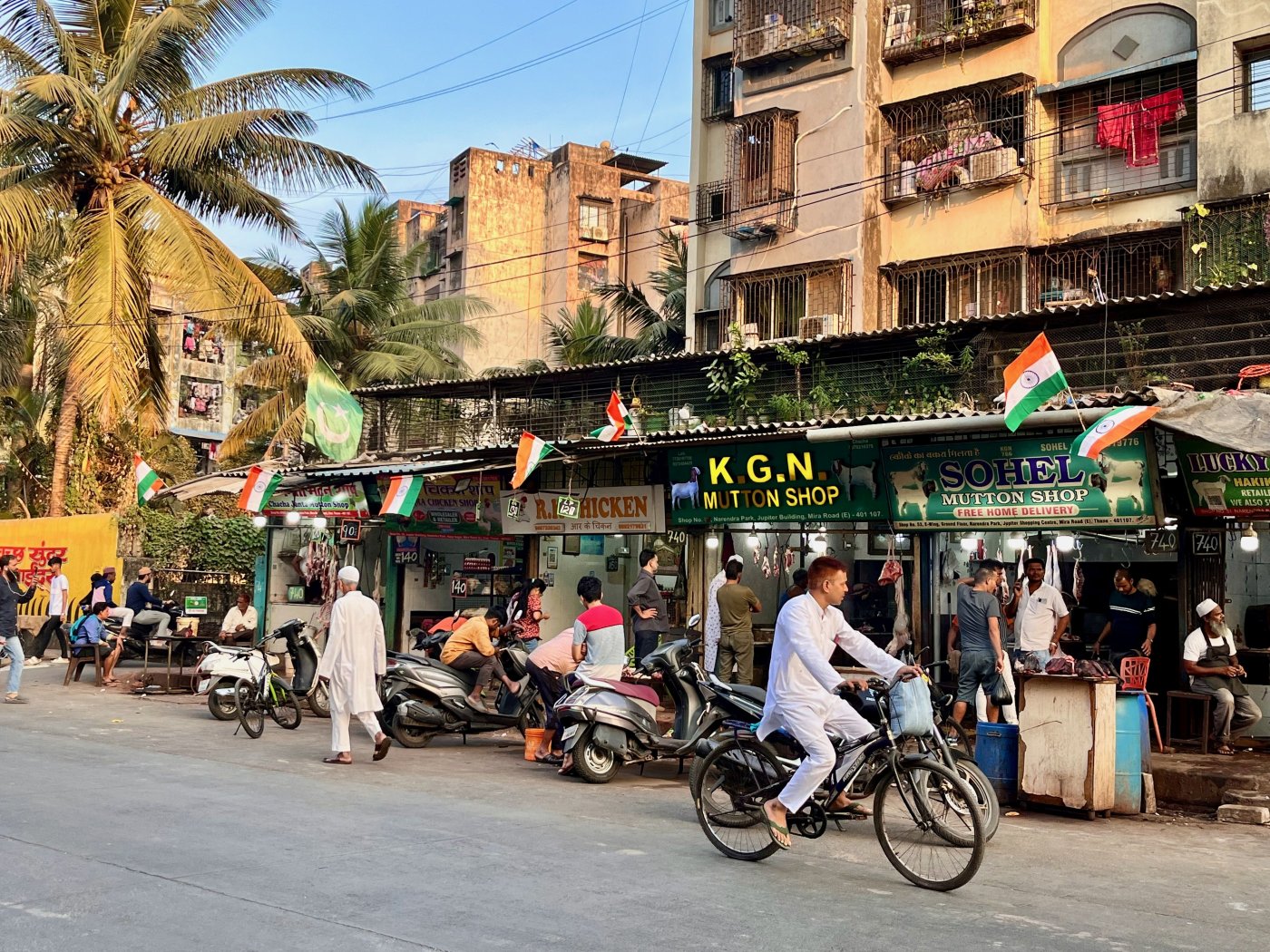Mumbai: On 7 April 2023, a silver Toyota Innova slowed in Naya Nagar, a densely populated Muslim neighbourhood of Mira-Bhayander, a suburb 40 km north of Mumbai.
It was only 4:30 am, but the Shams Masjid lane was busy, as it always was on Ramzan mornings, residents making purchases at Usman Mithaiwala, Shandar Zaika and a clutch of other local favourites before the fajr (pre dawn) prayer and the beginning of the day’s fast.
The SUV turned into a lane beside the mosque, then immediately turned around and emerged from the Shams Masjid lane where it pulled up.
Three men were in the car. One rolled down a window, looked pointedly towards the Muslim mosque-goers and shouted provocative Islamophobic comments. Before policemen along the partially barricaded road could reach it, the car sped away.
A first information report (FIR) was filed in the case under section 153 A (promoting enmity between different groups) of the Indian Penal Code (IPC), 1860, against unidentified accused. It was one of three very similar incidents in Mira-Bhayander that Ramzan, provocations, said locals, to riots that did not occur.
On 21-23 January 2024, the outcome was different when scores of Hindus bearing saffron flags, wearing saffron scarves and kurtas, and shouting Jai Shri Ram as a war cry rode and drove through Naya Nagar around 10:30 pm.
After their first face-off with a mob of angry Muslim men on a dead-end road, riotous mobs of Hindus attacked Muslim shops, street vendors and passers-by as political and community leaders, instead of calming tempers, fanned the flames.
Early on 22 January, about three hours after the first skirmish, the Sudarshan News channel’s X handle called the mob action a “jihadi” attack. Jihadis, or those claiming to undertake a holy war to protect Islam, is a common slur used by Hindu nationalists to present Muslims as terrorists.
The post recorded more than 800,000 views over the days that followed.
The Transformation Of Geeta Jain, MLA
As videos of the attack were being shared widely on WhatsApp and X the following morning, the ruling Bharatiya Janata Party’s (BJP) Mira-Bhayander legislator Geeta Jain posted on her X handle: “Attacks on Sanatani brothers and sisters will not be tolerated.”
On 23 January, her “give-us-only-five-minutes” retort about proving Hindus’ might to Muslims made her a darling among Hindu nationalists, marking the completion of her gradual transformation from a rebel candidate against the BJP in 2019—snubbed for the official party ticket and expelled for not withdrawing her candidature—to a burnished Hindu nationalist leader.
She won on a widely appreciated campaign that was secular (see here, here, here), and spoke of development, women’s rights and employment. In 2015, she had even tried to organise an iftaar party on the municipality’s funds.
Intensifying Hindu nationalism in Jain’s recent speeches and programmes in the Mira-Bhayander suburb are apiece with growing instances of inflammatory hate speech and communal incidents in Maharashtra, as Article 14 reported in October 2023—41 communal incidents in the first 10 months of that year, with 10 dead.
“It is 100% an attempt to polarise Mira-Bhayander,” said Dhananjay Shinde, a leader of the Aam Aadmi Party’s Mira-Bhayander unit. “In the absence of real development work, this is an attempt by local leaders to get the BJP ticket for the elections in 2024.”
More than 1,000 police personnel including platoons of the State Reserve Police Force and the Rapid Action Force were deployed in Mira-Bhayander in subsequent days. At least 25 people were arrested in different cases, for rioting and posting inflammatory content on social media.
Among a series of fake videos circulated as depicting violence in Mira-Bhayander was one of a railway station on fire—it was a year-old video from West Bengal.
Known for its small-scale industry hub that manufactures small machine spare parts among other goods, Mira-Bhayander, with a 2011 Census population of 809,000, has witnessed a rapid influx of people over the last two decades, pushed out of the financial capital on account of high prices and attracted to the availability of land in Mira-Bhayander, its proximity to Mumbai.
Local residents including teachers, businessmen, small traders and activists told Article 14 that in the absence of development works, on the ground, a communal cauldron will provide a platform to mobilise voters months before the national and Maharashtra assembly elections.
Over 50 Will Face Attempt-To-Murder Charge
The FIR registered at Naya Nagar police station for the first skirmish on the night of 21 January between a mob of Muslim residents and Hindu motorists and their families in a triumphal cavalcade invokes section 307 of the IPC (attempt to murder), which carries a possible life term.
According to this FIR, filed on the complaint of a trader named Vinod Jaiswal, four cars and 10 two-wheelers were to take what he described as a casual late evening joyride. (Visuals of the vehicles captured at the end of the skirmish showed a microphone on one backseat, saffron scarves and saffron flags on the vehicles.)
On running into traffic on the Kashimira highway, they turned around and turned into the Naya Nagar and Lodha Road areas of Mira Road. Here, according to Jaiswal, a youth stopped them and asked if Ram would now come to protect them.
A mob of 50-60 Muslims shouting “Allahu akbar (god is great)” and wielding weapons, including sticks and rods, then allegedly rushed towards them, grabbed the saffron flags on their vehicles and snapped them underfoot, while one attacker also allegedly vomited on a decal photo of the deity Hanuman on the hood of one of the cars.
Jaiswal, 43, sustained a knife injury to his right cheek, he told police. The mob also hurled stones and attacked the children, women and men in the vehicles, Jaiswal’s statement recorded in Marathi said, calling it a “jive thaar maarnyacha prayatna” or murderous attack.
Nearly 15 men from Naya Nagar were arrested in days that followed the FIR, with more arrests likely, all charged with attempt to murder.
Residents of Naya Nagar said, however, that no knife was used, and that the weapons listed by the police—rods, batteries, weights—were simply whatever the mob found in the marketplace.
“We don’t condone the violence, particularly against women and children,” said Mira Road resident Rafique Shaikh, secretary of non-profit organisation Hum Bharatiya and president of a citizens’ group called the Daksha Nagrik Sangh.
Rafique Shaikh said local Muslims also welcomed the arrest of YouTuber Abu Shaikh, for a video message goading Hindus, though without any abusive language.
Different Laws Used For Hindu & Muslim Attackers
“The only disappointing thing is the vastly different sections of law applied to very similar crimes,” Rafique Shaikh said. “All these boys picked up for attacking the cars will face attempt to murder charges though the injury is to one man, on his cheek.”
Four minor boys were among the 13 arrests that police initially made in this case. They were aged 16 and 17 years, detained at the Naya Nagar police station, and brought by their parents to the children’s court the next day as per the Juvenile Justice (Care and Protection of Children) Act, 2015.
Another 40-45 men were wanted in connection with the same incident. The police’s first application for custodial interrogation did not assign individual roles to the 13 accused. It said the use of sticks, rods, knives and other weapons by a large mob of 50-60 persons made it a serious crime.
In contrast, transporter Abaidul Haque Chaudhary, a native of eastern Uttar Pradesh’s Bassi district, visited the Mira Road police station three days in a row, twice daily, first to ask for an FIR to be filed, and then to coax officers to investigate and make arrests.
Chaudhary is the owner of the tempo seen in a viral video of a mob stopping the vehicle in Shanti Nagar, the more predominantly Hindu part of Mira Road.
The vehicle was identified as Muslim-owned by the name ‘Rashid’ painted on its side, and a star symbol, Chaudhary told Article 14. In the video, a mob of young men wielding saffron flags and sticks are seen stopping the tempo, attacking the driver, Chaudhary’s son Tariq (21), then climbing on board and attacking one of Haque’s employees, Matiullah Sah (22).
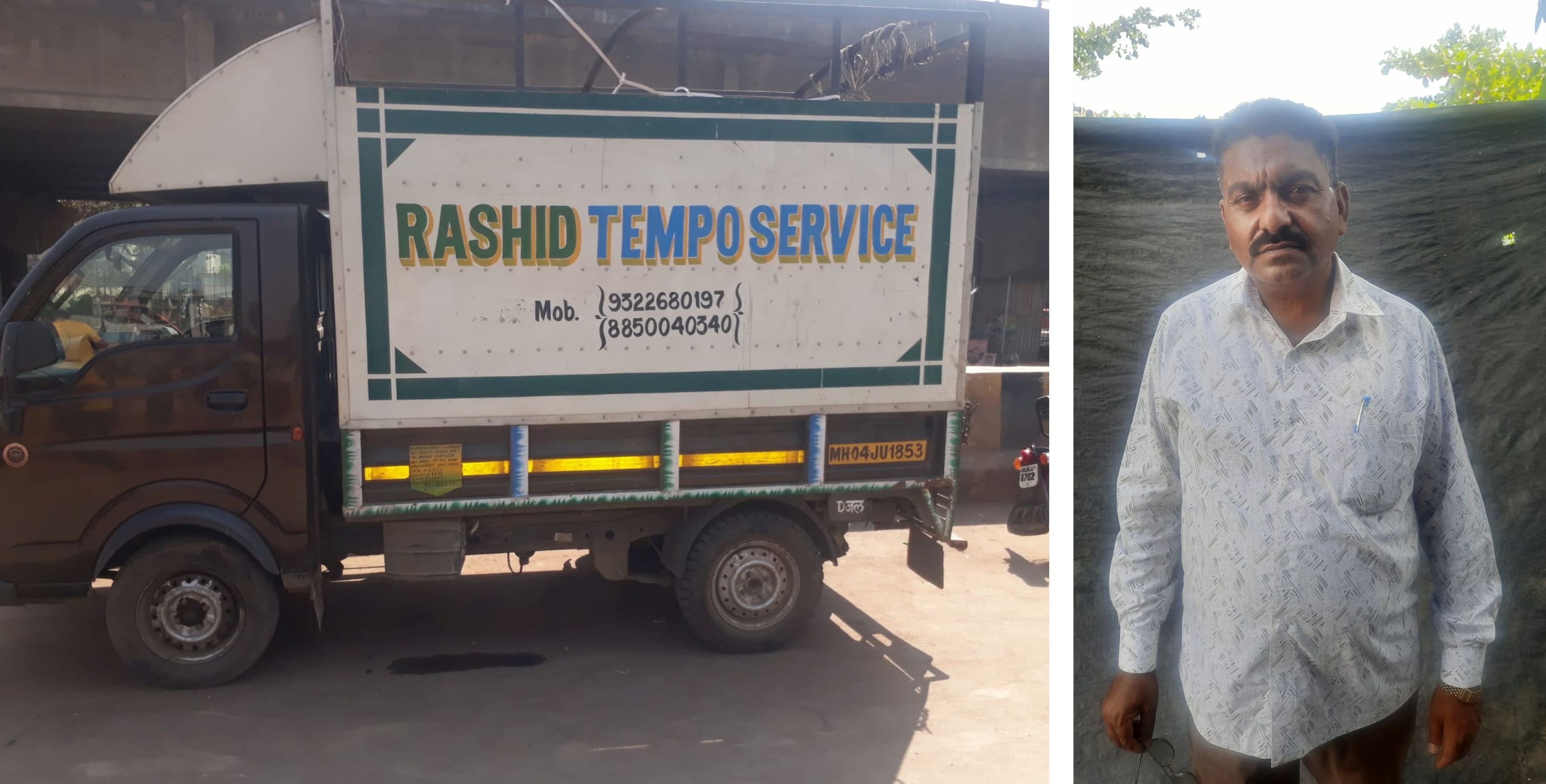
Sah received three stitches for a small but deep gash on his head, Haque said. On the video, there appeared to be at least 10-12 assailants, many of their faces plainly visible.
The incident occurred on 23 January. The FIR in the case was filed on 24 January against unidentified assailants, under sections 141 (unlawful assembly), 143 (member of an unlawful assembly), 147 (rioting), 149 (every member of unlawful assembly guilty of offence committed in prosecution of common object), 324 (voluntarily causing hurt by dangerous weapon or means), 341 (wrongful restraint) and 427 (mischief causing damage to the extent of fifty rupees) of the IPC.
“We identified some of the boys who attacked the tempo,” Chaudhary told Article 14. “We are 110% sure of it.”
Through social media, Chaudhary’s son and others established that the boys are most likely residents of the Tankerpada and Gaothan areas of Mira-Bhayander.
No arrests were made in the case until 1 February.
The maximum punishment under the sections of law applied in Chaudhary’s complaint would be three years’ imprisonment.
“Muslim boys identified through videos were picked up quickly,” Chaudhary told Article 14 over the phone on 1 February, “but not the Hindu boys seen so clearly attacking my tempo.”
He said he had spent upwards of Rs 30,000 to repair the vehicle, and had incurred losses of Rs 50,000-Rs 70,000 for the eight days that it was in the workshop.
Another Brutal Attack, A Rioting Charge
As news of the Naya Nagar attack on a Hindu motorcade spread, Hindu mobs attacked Muslim shops and establishments.
In one incident, a group of men attacked Ola cab driver Jabir Siraj Ansari in the wee hours of 22 January near Maxus Mall in Bhayander (West), barely 1 km from Bhayander police station.
Ansari had two passengers in his Swift Dzire when he was stopped by three or four men. Ansari told police that as soon as he gave his name, one man began to hit his windshield with a wooden stick. His passengers fled, and two more men rushed to the cab, dragged Ansari out and repeatedly struck him with sticks.
They fled when a patrolling policeman approached, but not before smashing the windshield and all the windows of his car, also damaging the hood and the rear, the taxi driver told police. Ansari said he could identify the assailants if they were brought before him.
A private imaging centre’s report of a CT scan showed Ansari suffered a fracture of the nasal bone, multiple fractures of the sinus, multiple fractures of the right cheekbone and multiple fractures to the orbit or the socket of the skull that holds the eye. Ansari’s complaint said he also sustained injuries to the right wrist and right leg.
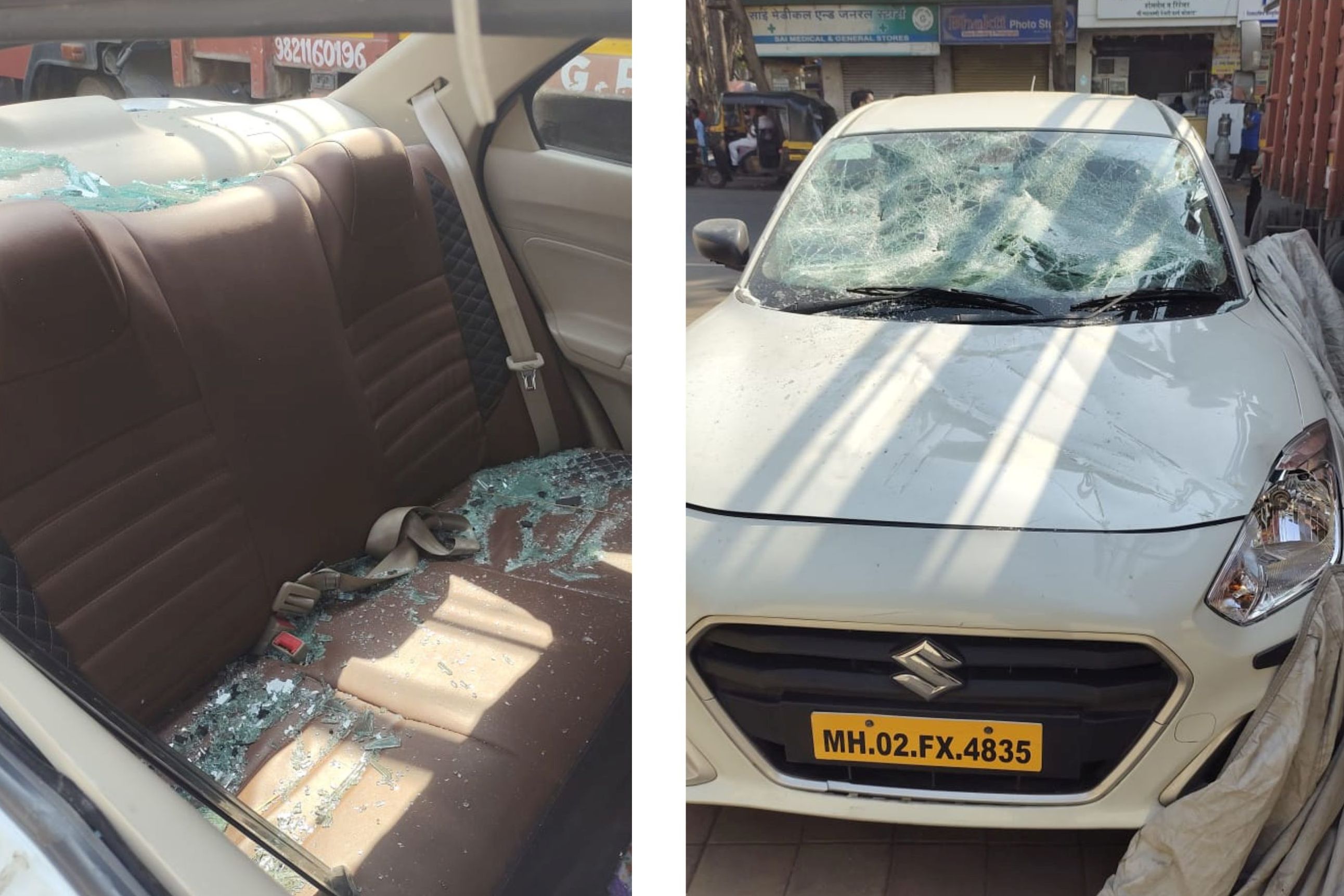
Holding that his injuries are more severe than the police initially assessed, Ansari, assisted by advocate Shahood Anwar Naqvi, wrote to commissioner of the Mira Bhayander Vasai Virar police asking for a modification in the charges, specifically to add section 307 (attempt to murder) to the FIR.
Filed at the Bhayander police station on the afternoon of 22 January, the FIR invoked only sections 324 (voluntarily causing hurt by dangerous weapon or means), 427 (mischief causing damage to the extent of fifty rupees) and 34 (acts by several persons in furtherance of a common intention) of the IPC. The maximum punishment under section 324 is three years’ imprisonment.
‘In Fear, I Said Jai Shri Ram’
Ashfaqueali Akbarali Shaikh, 34, a Plaster Of Paris supplier, was returning home from Kandivli on the evening of 22 January when he was accosted on the Bhayander railway overbridge by a group of five to six men.
They identified him as a Muslim from the alphabets KGN (referring to Khwaja Garib Nawaz) on his Activa scooter, and called him a “katua” (a slur for Muslim men).
As the men attacked him and his scooter with sticks, Ashfaqueali Shaikh fell to the ground but did not sustain major injuries on account of wearing a helmet. The men continued to damage his two-wheeler, shouting all the while, and Ashfaqueali Shaikh finally gave in.
“In fear, I said ‘Jai Shri Ram’ to the mob,” he said, describing the incident as an attack on his religious sentiments. Ashfaqueali Shaikh found out shortly that a crowd had also thrown stones at the Kabrastan masjid in Bhayander (West).
A16-year-old boy who was stopped and attacked in Bhayander (West) on 23 January evening by members of a Hindu rally sustained bruises on his shoulder, leg and back, and also lost a tooth when an attacker landed a blow to the teenager’s face.
A mob of 10-15 Hindus shouting Jai Shri Ram attacked him and his father as they returned home from namaz on their two-wheeler, according to his statement to the police. A friend’s shop where they had been chatting was vandalised too, as was their two-wheeler. “They were forcing us to say Jai Shri Ram,” the boy told the police in his statement.
Asked if the average Hindu in Mira-Bhayander felt fear of or anger towards their Muslim neighbours, Sudhanshu Pandey, a Hindu resident of Mira Road, said the attack on the night of 21 January in which a Hindu woman also sustained an injury, followed by the provocative video by Abu Shaikh in which he said Hindus would not be able to react and the use of social media to share these videos widely had angered many apolitical and otherwise non-partisan Hindus in the area.
Hate Speech To Normalise Exclusion
The violence from 21 to 23 January was the flashpoint of a disquiet that has simmered in Mira-Bhayander since early in 2023.
In March 2023, breaking from her image as a ‘secular’ candidate during the Assembly elections of 2019, Jain flagged off the Hindu Jan Akrosh Morcha (translated as Hindu people’s march in anger) organised by the Sakal Hindu Samaj, a federation of Hindutva organisations.
The morchas or rallies by Hindu groups had already been caught in the crosshairs of the courts, and only in February had the Supreme Court directed the government of Maharashtra to give permissions to these rallies only on the condition that no hate speeches would be made.
The state government, represented by solicitor general Tushar Mehta, assured the Supreme Court that a morcha scheduled for 5 February would not disturb public order, and that police would videograph the proceedings.
At the Mira Road event on 12 March, several hundred Hindus and workers of the BJP, Vishwa Hindu Parishad, Bajrang Dal, Hindu Jagran Manch, Hindu Rashtra Sena and other Hindu nationalist groups marched 2 km from the upscale Golden Nest circle and past Naya Nagar to Salasar Center Park.
The main draw at the rally was Kajal Shingala, a self-styled Hindutva social media influencer who goes by the name Kajal Hindustani, whose rise—abetted by social-media companies ignoring their own hate-speech standards—Article 14 chronicled in April 2023.
Addressing the crowd of sloganeering Hindus (see here, here and here), Shingala called for the economic boycott of Muslims, referred to the non-Hindu residents of Mira Road as chadarwala (Muslims) and fatherwala (Christians) and claimed, without evidence, that Naya Nagar was a hub of the narcotics trade.
The Sakal Hindu Samaj’s stated objective behind the rally was to protest alleged cases of ‘love jihad’ and ‘land jihad’, referring to the conspiracy theory Hindutva organisations subscribe to, of a secret campaign by Muslim men to lure and convert women of other faiths and to take over lands owned by non-Muslims.
Shingala claimed that Muslim fruit vendors mixed medicines in produce sold to Hindus, to induce napunsakta (infertility). Jihadis had taken over Naya Nagar, she said. The vitriolic speech appeared well-timed—Ramzan was 11 days away.
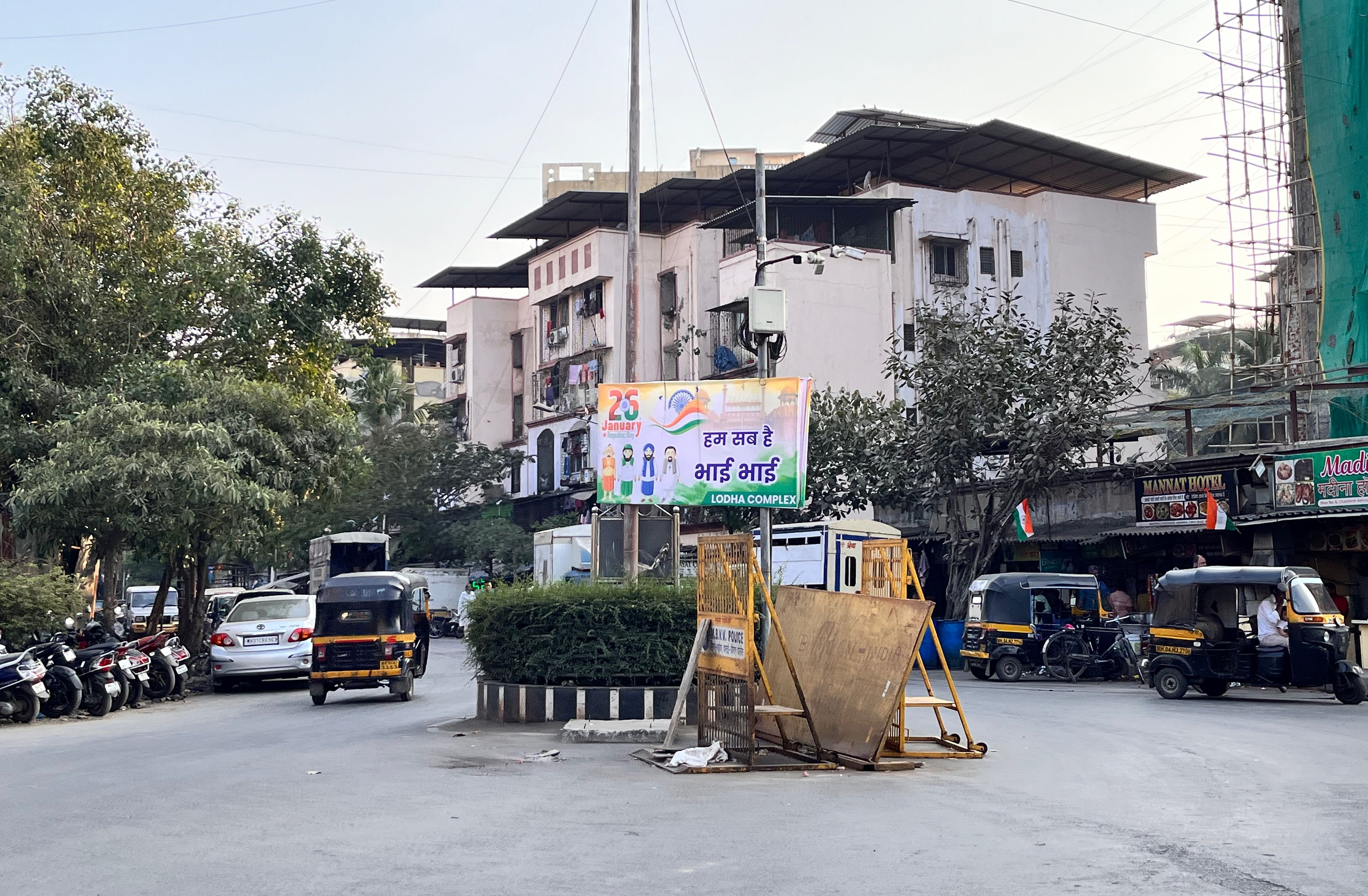
‘They Can Never Be Your Brothers’
More than a month later, following requests from local organisations and residents, in April 2023, the Mira Bhayander Vasai Virar police, without a complaint, booked Shingala under sections 153 A and 505(2) of the IPC. The sections pertain to promoting enmity between different groups on grounds of religion, race, place of birth, residence, and language/acts prejudicial to the maintenance of harmony. Shingala was arrested in April, but in a case filed in Gujarat.
“Do not think that this labelling of our localities as home to ugravadis (terrorists) is without real impact on our lives and businesses,” said Sayed Jishan Haider, a long-time resident of Naya Nagar and a businessman. A contractor for the railways, Haider said he was recently asked by a business associate, half in jest, whether he resided in a terror hub.
Undeterred by the cases, meanwhile, Shingala has continued to address rallies of Hindu groups across central and western India, and will be in Vidarbha, in eastern Maharashtra, at two separate events in the first week of February.
Hours after violence broke out in Mira-Bhayander, on 22 January, Shingala posted a tweet that reiterated her suggestion to christen Naya Nagar as ‘G-hadi’ Nagar (town of jihadis). “They were jihadis, they are jihadis and they will remain jihadis,” she posted, in Hindi. “They can never be your brothers.”
She posted videos from the previous night, of a mob attacking a cavalcade of cars and bikes, including that of a car with a vandalised decal sticker of a Hindu deity on its hood. The tweet recorded more than 40,000 views over the next few days.
Slow-Burn Rabble-Rousing
A week after Kajal Hindustani’s hate speech at Mira-Bhayander’s Hindu Jan Akrosh rally, the suburb hosted controversial Hindu spiritual leader Dhirendra Shastri of north-eastern Madhya Pradesh’s Bageshwar Dham.
A YouTuber and self-styled godman—who declared later in the year while on a visit to Bihar that India was already a Hindu nation with only the official declaration pending— Shastri reportedly addressed a sabha (meeting) of more than 50,000 Hindus in Mira-Bhayander.
To his over 5 million YouTube subscribers, Shastri is a mind-reader and visionary, tens of thousands flocking to listen to his sermons even after he ducked a challenge posed by a rationalist to display his supposed spiritual powers.
The Mira Road satsangs, supposedly spiritual discourses, were held despite objections (see here and here) by the state unit of the Congress and the Maharashtra Andhashraddha Nirmoolan Samiti, a non-profit that has campaigned for decades against superstition.
The Maharashtra Andhashraddha Nirmoolan Samiti was founded in 1989 by Narendra Dabholkar, the rationalist gunned down in Pune in 2013, allegedly by Hindu nationalists.
At a press meet during his Mira Road visit, his comments punctuated by chants of Jai Shri Ram, Shastri said it would be Maharashtra that birthed a ‘Hindu rashtra’ (Hindu nation), and that Hindus would hoist their flag “on the chests” of those who opposed Indian culture and saints.
For Jain, the local legislator who stood right behind Shastri as he made the comments, the carefully calibrated intensification of her Hindu nationalism over a period of several months will be a key element in her bid to win the BJP ticket to defend her legislative constituency when Assembly elections are held in October 2024.
Indeed, Jain could be in a three-way contest for the BJP ticket, and the other two prospective candidates in the fray have tried to outdo her Hindutva with their own jingoism.
Competitive Hindu Nationalism
One of the two competitors against Jain for the BJP ticket is Ravi Vyas, the BJP’s district president, who has not only attended and supported a series of public meetings and sabhas of godmen and religious groups but also inaugurated a “mini” replica of the Ayodhya temple in Mira-Bhayander.
The other is former BJP legislator Narendra Mehta, who Jain defeated in 2019 when she contested as a BJP ‘rebel’ candidate. Mehta even scheduled a ‘Shriram Shanti Tiranga Yatra’ or a flag march in the name of Ram on 26 January, along a planned route that was more or less the same as the Hindu Jan Akrosh rally of 2023.
Mehta called off the march after a delegation of local residents and representatives of non-profits met deputy chief minister Ajit Pawar at his Malabar Hill residence in south Mumbai, requesting his intervention in quelling any further provocation to disturb a delicate peace.
(Mehta was in the news in 2023 when his son drove his Rs 3-crore Lamborghini Huracan into the divider of the Bandra Worli Sea Link. In 2016, Mehta’s wife collided with an autorickshaw while trying to make a U-turn in her Lamborghini. Visuals of the accident went viral on social media.)
Not to be left out, the Shiv Sena (Eknath Shinde group) organised a Ram Rajya Rath Yatra of hundreds of motorbike-riding men shouting slogans and waving saffron flags along Mira Road’s main junctions all the way to Bhayander.
Isolation & Anxiety For Young Muslims
Since Diwali 2023, every time A* walked into class at a prominent college in Mira-Bhayander, she felt the eyes of a small group of classmates on her, the 20-year-old first year student told Article 14, requesting that her identity and that of her college not be revealed.
Occasionally, as A passed by, her head covered with a headscarf, this all-boys group would call out: Jai Shri Ram!
A said she ignored it, even though the slogan felt like a catcall. Only three or four girls in the class wore the headscarf or a burqa. She confided in a friend, who agreed that the boys were best ignored.
About a week before the recent violence, A arrived in college an hour before an exam and sat with a friend in their nearly empty classroom, going over their notes. Two young boys, classmates she recognised, shouted Jai Shri Ram as they passed.
“I lowered my gaze,” A told Article 14 over the phone. “I did not want to cause any trouble.”
The goading continued, and the boys broke into song: “Bharat ka bachha bachha Jai Shri Ram bolega (Every single child in India will say Jai Shri Ram.)”
It was one of several wildly popular Hindutva-pop songs now belted out by Hindu right-wing activists during rallies and events. When A went outside the classroom briefly, the two boys shouted the slogan again.
Eventually, worried about returning to a Hindu-majority classroom after the recent violence, her friend reported the matter to a senior fellow student, also a Muslim, who told Article 14 he planned to keep an alert eye on the situation, in the eventuality that it deteriorates.
A said the odds may already be stacked against many young Muslim women trying to complete their higher education, and polarisation and the fear of communal violence as witnessed in Mira-Bhayander over the last six to eight months made these girls even more vulnerable.
Islamophobia In College: Common, Unexceptional
Communal and incendiary comments by college students appeared to be commonplace, unexceptional incidents.
Another resident told Article 14 that a screenshot of a students’ WhatsApp group had been shared around just weeks before the Ayodhya Ram temple consecration: “Yahaan pe mulle zyaada ho gaye hain (The number of Muslims here has grown),” a message on the group reportedly said.
Younger children too were not cloistered from the gradually fraying social cohesion of the suburb.
A Muslim politician of a regional party who has lived in Mira-Bhayander for well over a decade recounted how his son was cornered in his Class X classroom days after the recent violence.
“Three-four boys from his class grabbed his collar and demanded that he say Jai Shri Ram,” the politician told Article 14, requesting not to be identified in order to protect the school’s image and his son’s classmates.
The 15-year-old did not react. Once the teacher arrived in the classroom, the boys stepped away from him. He recounted the incident to his mother later that day, and the worried parents called the school principal who reportedly offered to expel the boys, prompting their parents to call and offer profuse apologies.
The family decided not to pursue the matter.
The boys had been classmates right through school, from class I to class X. “We all know one another well,” the politician said. “It was a sad thing to see children’s minds turn this way.”
It was not an isolated incident.
A Hindu resident told The Wire that his son’s WhatsApp group with classmates had seen messages asking if the kids were “kattar” (rigid or fundamentalist) Hindus.
Another resident told Article 14 of an incident in which young school boys pounded on the metal gate of an English school run by missionaries and screamed Jai Shri Ram before scampering off.
Between 2 Ramzans, A Year Of Unease
After the first face-off between a cavalcade of vehicles bearing saffron flags and a crowd of Muslim residents in Naya Nagar, amid the fog of a spreading communal clash, BJP legislator Geeta Jain spoke to local television news on 23 January.
“They’re saying give us 15 minutes or 10 minutes, but our numbers are so much larger that we will only need five minutes. Give us five minutes,” she said in a viral video that she later pinned atop her X handle.
Jain had visited the police commissioner’s office earlier that evening, and had demanded that barricading on the road into Naya Nagar be removed.
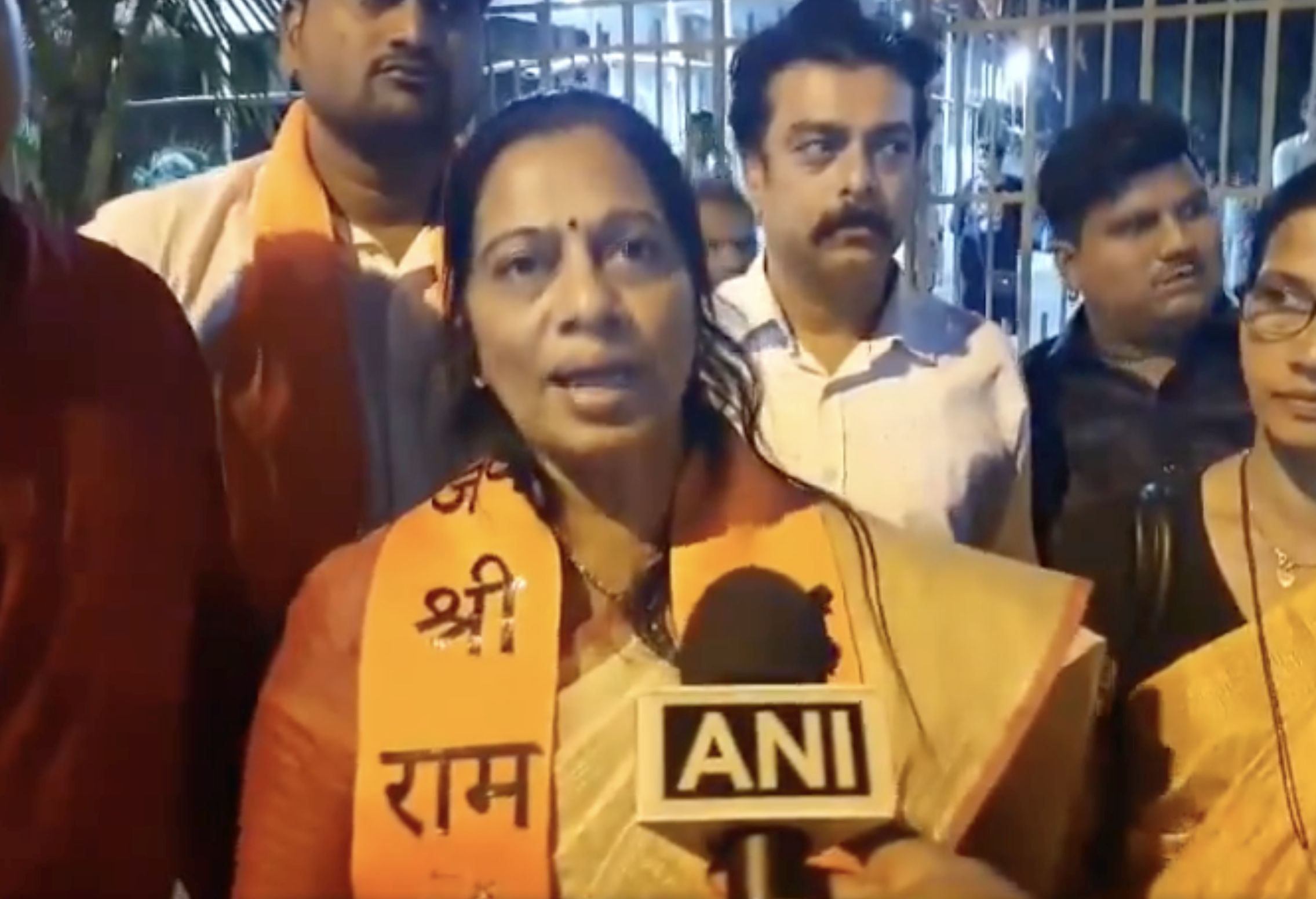
“Yeh kaunsi lokshahi hai? (What kind of democracy is this?)” she said, adding that regions could not be demarcated as ‘ours’ and ‘theirs’, and those wishing to use the road could not be asked to display their Aadhaar cards before they were allowed to pass.
Backing her up on the demand to remove the barricading was Nitesh Rane, BJP legislator from Kankavli in Konkan’s Sindhudurg district, who arrived in the tense town located 500 km north of his own constituency on 23 January, and met Hindus who had been attacked in Naya Nagar.
The previous morning, he had already posted a tweet on his X handle in response to the violence of 21 January evening: “.. chun chun ke maarenge (we will not spare anyone)”.
Both legislators were indicating that the barricading aimed to demarcate Muslims’ territory within the suburb. Jain said Rane and she had told the police commissioner that if the barricading was not removed, they would return and remove it themselves.
Through the month of Ramzan in 2023, the Mira Bhayander Vasai Virar police kept parts of Naya Nagar barricaded, as a precaution against small face-offs between Hindus and Muslims flaring into a conflagration.
Rafique Shaikh of Hum Bharatiya said police barricading had been put in place after three incidents that bore considerable similarity to the first skirmish of 21 January evening—men on bikes or in cars shouting Hindu slogans had approached mosques, where large groups of Muslim men gathered outside before or after the prayer.
“We had very firmly resolved that no amount of provocation should result in any Hindu being attacked,” said Rafique Shaikh. In two of the three incidents, the men who appeared to be looking to ignite trouble were held back and handed over to the police, unharmed.
Rafique Shaikh and several other Naya Nagar residents told Article 14 that the barricaded road had remained a peaceful thoroughfare for years, barring the periods when police barricading was erected during sensitive times to maintain peace.
There had never been any claim that this was Muslim territory, the residents said.
“Hindus used that road without any trouble at all other times, right?” asked Shaikh.
With the month of Ramzan approaching in March, residents said the sharp polarisation and the role of politicians in the approach to general elections in April had made them wary.
(Kavitha Iyer is a senior editor with Article 14 and the author of ‘Landscapes of Loss’, a book on India’s farm crisis.)
Get exclusive access to new databases, expert analyses, weekly newsletters, book excerpts and new ideas on democracy, law and society in India. Subscribe to Article 14.

